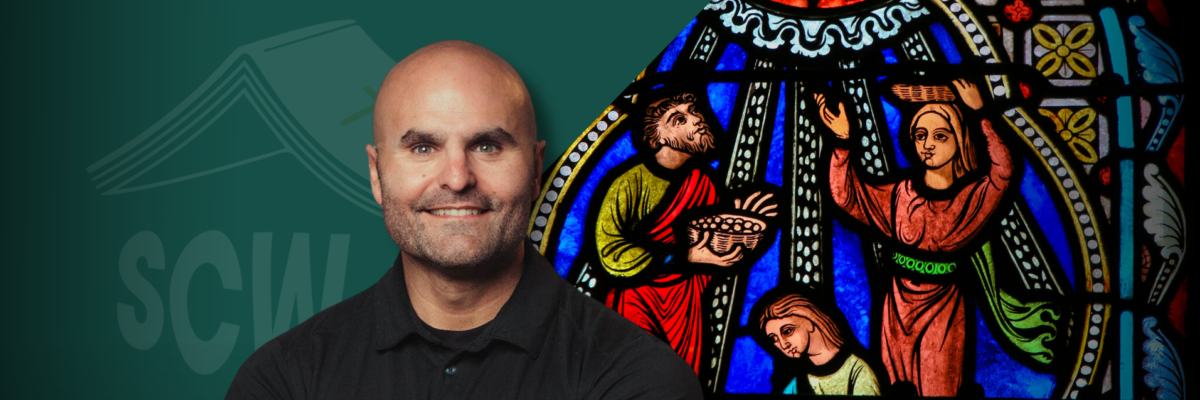
Episode 123: Year C – 4th Sunday of Lent
In today’s episode, we focus on three details that are relevant for doing apologetics. The first comes from the first reading, which is taken from Joshua 5:9a, 10-12. The relevant apologetic topic is the Eucharist, and more specifically the belief that the Eucharist is not merely a symbol. The other two details come from the second reading, which is taken from 2 Corinthians 5:17-21, and each has to do with the question of whether justification is merely forensic or a state of interior righteousness. One detail is presented as support for the interior righteousness view, and the other detail is presented against it.
Readings: Click Here
Looking for Sunday Catholic Word Merchandise? Look no further! Click Here
Hey everyone,
Welcome to The Sunday Catholic Word, a podcast where we reflect on the upcoming Sunday Mass readings and pick out the details that are relevant for explaining and defending our Catholic faith.
I’m Dr. Karlo Broussard, staff apologist and speaker for Catholic Answers, and the host for this podcast.
In today’s episode, we’re going to focus on three details that are relevant for doing apologetics. The first comes from the first reading, which is taken from Joshua 5:9a, 10-12. The relevant apologetic topic is the Eucharist, and more specifically the belief that the Eucharist is not merely a symbol. The other two details come from the second reading, which is taken from 2 Corinthians 5:17-21, and each has to do with the question of whether justification is merely forensic or a state of interior righteousness. One detail is presented as support for the interior righteousness view, and the other detail is presented against it.
Okay, let’s start with Joshua 5:9a, 10-12. Here’s what we read:
The LORD said to Joshua,
“Today I have removed the reproach of Egypt from you.”
While the Israelites were encamped at Gilgal on the plains of Jericho,
they celebrated the Passover
on the evening of the fourteenth of the month.
On the day after the Passover,
they ate of the produce of the land
in the form of unleavened cakes and parched grain.
On that same day after the Passover,
on which they ate of the produce of the land, the manna ceased.
No longer was there manna for the Israelites,
who that year ate of the yield of the land of Canaan.
The detail that I want to focus on is the comment that “the manna ceased” on the day after the Passover. This, obviously, indicates the miraculous quality of the manna. It appeared for forty years as they journeyed in the wilderness and upon entering the promised land it simply ceases.
“What’s the apologetical significance?”, you ask? The miraculous nature of the Old Manna provides us with a reason to conclude that the Eucharist is not merely a symbol.
Jesus reveals to us in John 6:48-51 that the Eucharist is the New Manna. He states,
48 I am the bread of life. 49 Your fathers ate the manna in the wilderness, and they died. 50 This is the bread which comes down from heaven, that a man may eat of it and not die. 51 I am the living bread which came down from heaven; if anyone eats of this bread, he will live for ever; and the bread which I shall give for the life of the world is my flesh.”
Notice the future tense: “the bread which I shall give.” Most biblical scholars agree that Jesus here is referencing what he will do at the Last Supper in giving us the Eucharist. Therefore, Jesus is drawing a parallel between the Eucharist and the Old Manna, thereby revealing the Eucharist to be the New Manna.
Now, as Bible scholar Brant Pitre argues in his book Jesus and the Jewish Roots of the Eucharist, to say the Eucharist at the Last Supper, the new manna, is merely a symbol, we’d have to conclude that the old manna in the wilderness was superior to the new, since miraculous bread is clearly greater than ordinary bread (Jesus and the Jewish Roots of the Eucharist, Chap. 4).
But that’s a no-go in biblical theology. The New Testament fulfillment is always greater than the Old Testament type. To use the language of the author of Hebrews in 10:1, Old Testament types are “shadows” of New Testament fulfillments. And, of course, the shadow is inferior to the thing that it is a shadow of.
Therefore, since the Old Testament Manna was a shadow of the New Manna, the Eucharist, it must be inferior to the New Manna. But this means the New Manna must be miraculous in some sense, which wouldn’t be the case if it were merely a symbol of Jesus’ body and blood.
So, the revelation of the Eucharist as the New Manna provides us reason to interpret Jesus’ words of institution at the Last Supper with a realistic understanding.
Let’s now turn to the second reading, which, recall, is taken from 2 Corinthians 5:17-21. Paul writes,
Whoever is in Christ is a new creation:
the old things have passed away;
behold, new things have come.
And all this is from God,
who has reconciled us to himself through Christ
and given us the ministry of reconciliation,
namely, God was reconciling the world to himself in Christ,
not counting their trespasses against them
and entrusting to us the message of reconciliation.
So we are ambassadors for Christ,
as if God were appealing through us.
We implore you on behalf of Christ,
be reconciled to God.
For our sake he made him to be sin who did not know sin,
so that we might become the righteousness of God in him.



